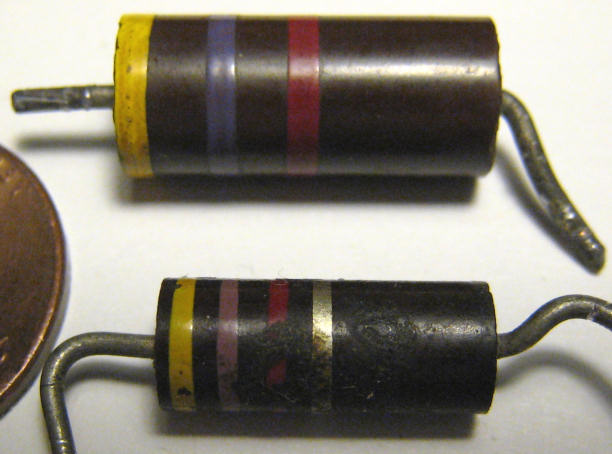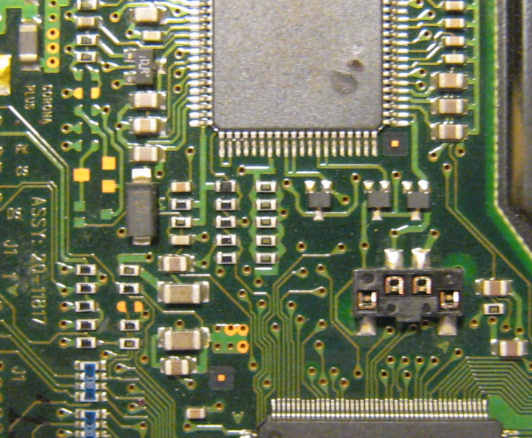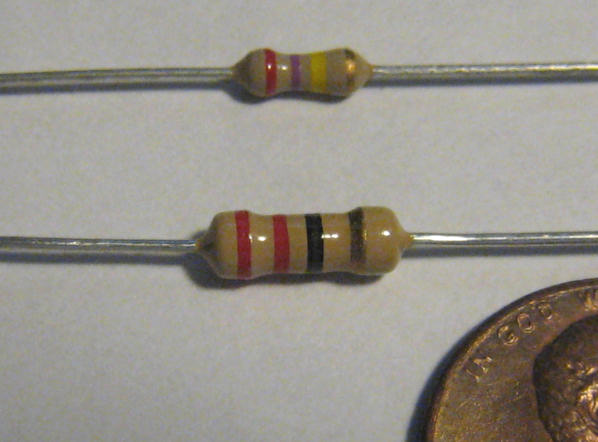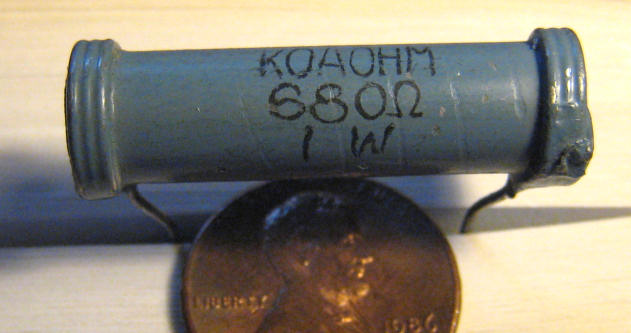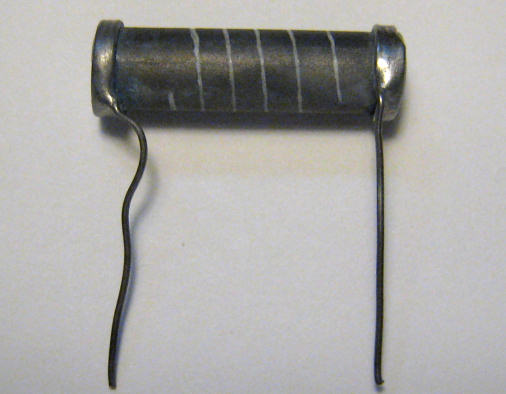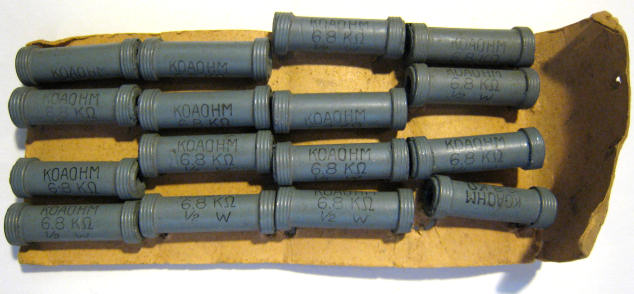- Schematic Symbols
- Formulas
- Radio
- Television
- Electronic Circuits
- Resistors
- Inductance
- Capacitance
- Tuned Circuits
Resistors
Why would anyone want to add resistance to a circuit? It seems like you would want to remove as much resistance as possible to more efficiently use your energy source, doesn't it? The fact of the matter is, resistance is absolutely required in most circuits as it acts as a current limiter. Some electronic parts will rebel by obstinately burning out if you try to run too much current through them. So, rather than having to regularly experience those unproductive events, we purposefully put some resistance into our circuits. And to accomplish that we add one or more of the components we call "Resistors". Resistors come in all manner of styles and shapes and are each designed for some specific application. The picture here is of a couple of carbon composition resistors, one is 1 Watt and one is 1/2 watt dissipation. These were working pulls from some electronic carcass I scavenged them out of. They now sit in my tool box; I just showed them here as this is one of the main kind of resistors I grew up seeing. There are pictures of several different resistor types that I have which will be illustrated on these pages. There is also some material here on how to read resistors and how they work and are manufactured. As already stated, there are several types of resistors. We have already seen an example of the carbon composition resistors. Those resistors were the workhorses for many years. Although they are still made, at least in China, there are better and cheaper alternatives more generally used today. Here is a list of the most common resistors with which I am familiar. There is commentary on some of these below and a few illustrations. This is not an exhaustive list. If you want to see some very good illustrations and all the tech specs on these, the KOA Speer Electronics web site has something for you.Common Resistors
- Surface-mount Chip-resistors
- Carbon film
- Metal film
- Metal-oxide film
- Wirewound
- Fusible
- Cement
- Network
- Current sensing
Surface-mount Chip-resistors
The bulk of resistors made for use today are chip-resistors. These are usually quite tiny resistors that are made for surface mounting on PCB boards. The first picture here is a close up of the controller board on an ancient (circa late 1990s) Quantum Fireball hard drive. On this board are numerous chip resistors. The next picture here shows a close-up of a few of these resistors. One resistor has "2R2" stamped on it. The full length of the tiny part is only about 2 mm or 1/16" across. The entire field of view in the last photo is only about 10 mm or 3/8" across. There would be no way that hard drives, or anything else electronic for that matter, could be made as small as what they are without these miniature resistors.Carbon-film Resistors
Next we look at carbon-film resistors. They employ a carbon-film on a ceramic type core to create their resistance. You can see a couple of examples here in this photo. These are a pair of carbon-film resistors. One is 1/2W and the other is 1/4W. There is a penny in the picture for a sizing reference. Carbon film resistors are cheap. You can buy them by the hundred for a couple or three bucks. If you can use more, like 5,000 at a time, the price can drop to less than a penny each.The next photo illustrates the way you will usually receive resistors when you purchase them in bulk. They sort of look like a set of railroad tracks. The resistors are held together on their leads by a set of parallel tape strips. They can then be folded to fit in most any package for delivery. If you buy enough of them they can come rolled up on a "reel" or neatly folded in a continuous sheet in an "ammo box".
Here are the "before" and "after" pictures of a KOA 1 Watt 680 ohm carbon film resistor. The "after" picture is after I stripped the paint from it. This was done to illustrate the carbon film and the spiral pattern that was cut into it. The spirals are helically cut by either a mechanical process, or sometimes today, with a laser. Then conductive wires are attached to the ends of the ceramic tube in contact with the carbon film. The part is then painted with an insulating paint and either color coding stripes or values are painted onto the surface.
As an interesting aside, the KOA resistors here are part of a group of NOS. (New Old Stock). The next picture shows the way these resistors were delivered in bulk.
Metal-film Resistors
Related to the Carbon-film resistors are Metal-film resistors. Usually from what I have seen, these come in a blue case. Usually also, there are five bands rather than four. The reason for this is that the Metal-film resistors can be made to a much tighter tolerance. Instead of the rather common resistor's 20% or 10% tolerance, Metal-film resistors are often 2% or 1% tolerance. And often they are low ohm value resistors. The extra band allows for a finer degree of identification.For a good javascript enabled resistor calculator I'd suggest you try out this one: 5 Band Resistor Color Codes. There are two additional links there to get you the values for four and six banded resistors as well.
